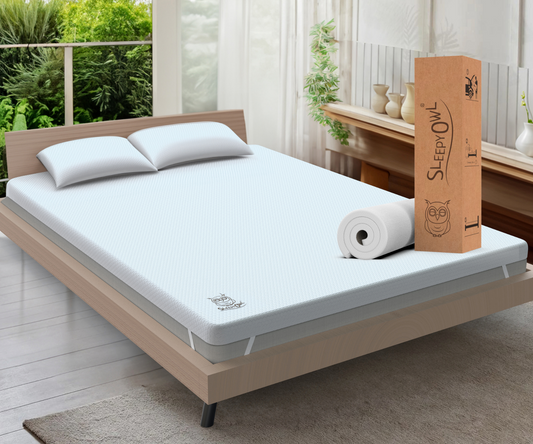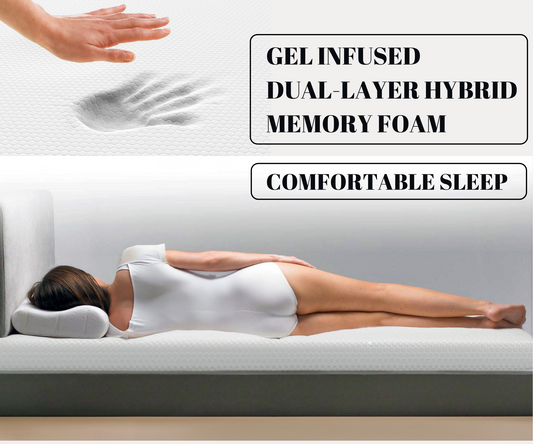How to Choose the Right Mattress
Sleep is a fundamental aspect of human health and well-being, yet it is often overlooked in our fast-paced lives. Understanding your individual sleep needs is crucial for selecting the right mattress, as it directly influences the quality of your rest. Factors such as age, lifestyle, and health conditions play a significant role in determining how much sleep you require and the type of support your body needs during those hours.
For instance, children and teenagers typically need more sleep than adults, while older adults may find that their sleep patterns change, requiring them to adapt their sleeping arrangements accordingly. Moreover, personal preferences regarding sleep environment can also affect your sleep quality. Some individuals may prefer a cooler room, while others might find comfort in a warmer setting.
Additionally, those who suffer from specific health issues, such as chronic pain or sleep disorders, may require specialised support from their mattress to alleviate discomfort and promote restorative sleep. By taking the time to assess your unique sleep needs, you can make informed decisions that will enhance your overall sleep experience. I recently purchased a new Memory Foam Mattress Topper for my bed.
Types of Mattresses: Memory Foam, Innerspring, Latex, Hybrid
The market offers a diverse range of mattress types, each with its own unique characteristics and benefits. Memory foam mattresses are renowned for their ability to contour to the body’s shape, providing excellent pressure relief and support. This material responds to body heat and weight, allowing it to mould to the sleeper's form, which can be particularly beneficial for those with joint pain or back issues.
Brands like Tempur-Pedic have popularised this technology, showcasing how memory foam can enhance comfort and support. In contrast, innerspring mattresses have been a staple in the industry for decades. They consist of a core of metal coils that provide support and bounce.
The level of firmness can vary based on the coil count and design. While they tend to offer good airflow and a cooler sleeping surface, they may not provide the same level of contouring as memory foam. Latex mattresses are another option, made from natural or synthetic rubber.
They are known for their durability and responsiveness, offering a buoyant feel that many sleepers appreciate. Hybrid mattresses combine elements from both innerspring and foam designs, aiming to provide the best of both worlds by offering support from coils while maintaining the comfort of foam layers.
Considerations for Different Sleeping Positions
Your preferred sleeping position significantly influences the type of mattress that will best suit your needs. Side sleepers often require a softer mattress that can cushion the shoulders and hips while maintaining spinal alignment. A mattress that is too firm may lead to pressure points and discomfort, making it essential for side sleepers to choose one that offers adequate contouring.
Back sleepers typically benefit from a medium-firm mattress that provides support for the lower back while allowing some sinkage at the shoulders. This balance helps maintain proper spinal alignment throughout the night. Stomach sleepers, on the other hand, generally require a firmer mattress to prevent excessive sinking of the hips, which can lead to misalignment of the spine.
Understanding these nuances can help individuals select a mattress that caters specifically to their sleeping position, ultimately enhancing their sleep quality.
Firmness Level: Soft, Medium, Firm
The firmness level of a mattress is a critical factor in determining comfort and support. Soft mattresses tend to provide a plush feel that can be appealing to those who enjoy sinking into their bed. However, they may not offer adequate support for all sleeping positions, particularly for back and stomach sleepers who require more firmness to maintain spinal alignment.
Medium mattresses strike a balance between softness and firmness, making them versatile options for various sleeping positions. They provide enough cushioning for side sleepers while still offering support for back sleepers. Firm mattresses are ideal for those who prefer minimal sinkage and require robust support for their spine.
The choice of firmness should be guided by personal preference as well as sleeping position to ensure optimal comfort and support throughout the night.
Budget-Friendly Options: Memory Foam Bed Topper, Mattress Pads
For those who may not be ready to invest in a new mattress but still seek improved comfort, memory foam bed toppers and mattress pads present excellent budget-friendly alternatives. A memory foam topper can be placed on top of an existing mattress to enhance its comfort level without the need for a complete replacement. These toppers come in various thicknesses and densities, allowing users to customise their sleeping surface according to their preferences.
Mattress pads serve a slightly different purpose; they provide an additional layer of protection for the mattress while also adding some comfort. They are typically thinner than toppers and can be made from various materials, including cotton or polyester blends. While they may not offer the same level of contouring as memory foam toppers, they can still improve the overall feel of an older mattress and extend its lifespan by protecting it from wear and tear.
When considering durability and longevity, traditional mattresses generally outlast memory foam bed toppers. A high-quality mattress can last anywhere from seven to ten years or more with proper care, depending on its construction and materials used. In contrast, memory foam toppers typically have a shorter lifespan, often ranging from three to five years before they begin to lose their supportive qualities.
While toppers can significantly enhance comfort in the short term, they are not a long-term solution for those seeking lasting support and durability. It is essential to weigh the benefits of investing in a new mattress against the temporary comfort provided by a topper. For individuals with specific health concerns or those who prioritise long-term investment in their sleep quality, opting for a durable mattress may be the more prudent choice.
Health Benefits: Orthopaedic Support, Allergen Resistance
A well-chosen mattress can offer numerous health benefits beyond mere comfort. Orthopaedic support is one of the most significant advantages associated with high-quality mattresses designed to promote proper spinal alignment. This is particularly important for individuals suffering from chronic pain or musculoskeletal issues.
Mattresses that provide targeted support can alleviate pressure points and reduce discomfort during sleep. Additionally, allergen resistance is an essential consideration for many sleepers. Certain materials used in mattresses are more resistant to dust mites, mould, and other allergens that can disrupt sleep quality and exacerbate respiratory issues.
For instance, latex mattresses are naturally resistant to dust mites due to their dense structure, making them an excellent choice for allergy sufferers. Investing in a mattress that prioritises both orthopaedic support and allergen resistance can lead to improved health outcomes and overall well-being.
Size Matters: Single, Double, King, Super King
Choosing the right mattress size is crucial for ensuring adequate space for movement during sleep. The standard sizes available include single (90 x 190 cm), double (135 x 190 cm), king (150 x 200 cm), and super king (180 x 200 cm). For individuals who sleep alone or have limited space in their bedroom, a single or double mattress may suffice.
However, couples or those who prefer more room to move around during sleep should consider opting for a king or super king size. The size of the mattress also impacts how well it accommodates different sleeping positions and preferences. A larger mattress allows for greater freedom of movement and can help prevent disturbances caused by one partner's movements during the night.
Additionally, larger sizes often provide more surface area for couples who may have different sleeping preferences or positions.
Trial Periods and Warranties: What to Look for in a Mattress
When purchasing a mattress, it is essential to consider trial periods and warranties offered by manufacturers. A trial period allows consumers to test the mattress in their own home environment over an extended period—typically ranging from 30 to 100 nights—before making a final decision. This feature is particularly valuable as it provides an opportunity to assess whether the mattress meets individual comfort and support needs.
Warranties are equally important as they protect consumers against manufacturing defects or premature wear. A standard warranty typically lasts between 10 to 20 years; however, it is crucial to read the fine print regarding what is covered under warranty terms. Understanding these aspects can help consumers make informed decisions when investing in a new mattress.
Eco-Friendly and Sustainable Options: Organic Mattresses, Natural Materials
As environmental awareness grows among consumers, eco-friendly and sustainable mattress options have gained popularity. Organic mattresses made from natural materials such as cotton, wool, or latex are increasingly sought after due to their reduced environmental impact compared to traditional mattresses made with synthetic materials. These organic options are often free from harmful chemicals and toxins commonly found in conventional mattresses.
Natural materials not only contribute to sustainability but also offer additional benefits such as breathability and moisture-wicking properties. For instance, organic cotton is known for its softness and durability while being grown without harmful pesticides or chemicals. By choosing eco-friendly mattresses made from sustainable materials, consumers can enjoy restful sleep while also supporting environmentally responsible practices.
Tips for Maintaining and Extending the Lifespan of Your Mattress
Proper maintenance is key to extending the lifespan of your mattress and ensuring it remains comfortable over time. Regularly rotating your mattress—ideally every three months—can help distribute wear evenly across its surface and prevent sagging in specific areas. Additionally, using a mattress protector can shield against spills, stains, and allergens while also providing an extra layer of comfort.
Cleaning your mattress periodically is also essential; vacuuming it every few months can help remove dust mites and allergens that accumulate over time. If possible, spot clean any stains with mild soap and water rather than soaking the mattress directly. Finally, ensuring proper support through a sturdy bed frame or foundation will help maintain its structural integrity over time.
By following these maintenance tips, you can significantly enhance your mattress's longevity and continue enjoying restful nights for years to come.
FAQs
What are the different types of mattresses available?
There are several types of mattresses available, including memory foam, innerspring, latex, hybrid, and air mattresses. Each type has its own unique features and benefits.
What should I consider when choosing a mattress?
When choosing a mattress, consider factors such as your sleeping position, body weight, firmness preference, and any specific health concerns such as back pain or allergies. It's also important to consider the mattress size and your budget.
How do I determine the right firmness for my mattress?
The right firmness for your mattress depends on your sleeping position and personal preference. Side sleepers may prefer a softer mattress, while back and stomach sleepers may prefer a firmer mattress. It's important to choose a mattress that provides adequate support for your body.
What is the average lifespan of a mattress?
The average lifespan of a mattress is around 7-10 years, although this can vary depending on the type and quality of the mattress, as well as how well it is maintained.
What are the benefits of a memory foam mattress?
Memory foam mattresses are known for their ability to contour to the shape of your body, providing excellent support and pressure relief. They are also effective at isolating motion, making them a good choice for couples.
How can I ensure that I choose the best mattress for my needs?
To ensure that you choose the best mattress for your needs, it's important to do thorough research, read customer reviews, and consider factors such as your sleeping position, body weight, and any specific health concerns. It's also a good idea to test out mattresses in person before making a decision.


